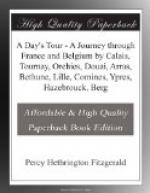It is a curious, not unromantic feeling, that of wandering about a strange town at midnight, and the effect increases as, leaving the place, I turn down a little by-street—the Rue de Guise—closed at the end by a beautiful building or fragment, unmistakably English in character. Behind it spreads the veil of blue sky, illuminated by the moon, with drifting white clouds passing lazily across. This is the entrance to the Hotel de Guise—a gate-tower and archway, pure Tudor-English in character, and, like many an old house in the English counties, elegant and almost piquant in its design. The arch is flanked by slight hexagonal tourelles, each capped by a pinnacle decorated with niches in front. Within is a little courtyard, and fragments of the building running round in the same Tudor style, but given up to squalor and decay, evidently let out to poor lodgers. This charming fragment excites a deep melancholy, as it is a neglected survival, and may disappear at any moment—the French having little interest in these English monuments, indeed, being eager to efface them when they can. It is always striking to see this on some tranquil night, as I do now—and Calais is oftenest seen at midnight—and think of the Earl of Warwick, the ‘deputy,’ and of the English wool-staple merchants who traded here. Here lodged Henry VIII. in 1520; and twelve years later Francis I., when on a visit to Henry, took up his abode in this palace.
[Illustration: BELFRY, CALAIS.]
Crossing the place again, I come on the grim old church, built by the English, where were married our own King Richard II. and Isabelle of Valois—a curious memory to recur as we listen to the ‘high mass’ of a Calais Sunday. But the author of ‘Modern Painters’ has furnished the old church with its best poetical interpretation. ’I cannot find words,’ he says in a noble passage,’ to express the intense pleasure I have always felt at first finding myself, after some prolonged stay in England, at the foot of the tower of Calais Church. The large neglect, the noble unsightliness of it, the record of its years, written so vividly, yet without sign of weakness or decay; its stern vastness and gloom, eaten away by the Channel




